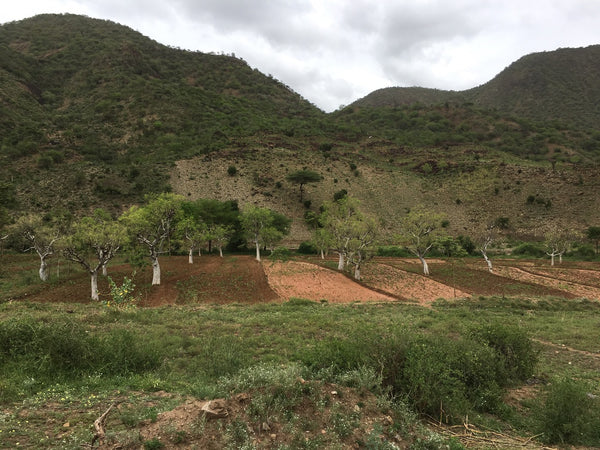Updates from the field

Updates from the field.
This is Tom. Together with Barb and Dr Luc I’m the third leg of the KAIBAE stool. I’m a humanitarian aid worker, botanist and the field-focused face of our work, often in communities living on the front lines of climate change. I’m here to offer a periodic window into this world of plants and trees and those communities trying to survive and make a living from them.
This first field update comes from Southern Ethiopia.
Consecutive years of below-average rainfall in the Horn of Africa have created one of the worst climate-related emergencies of the past 40 years, forcing millions of families to leave their homes in search of food and water, putting their health, safety and education at risk. The unprecedented impacts of multiple failed rainy seasons have created a humanitarian crisis in a region already negatively impacted by cumulative shocks, including conflict and insecurity, extreme weather conditions, climate change, high food and fuel prices, desert locusts and the extreme socioeconomic fallout of the COVID-19 pandemic. Reliance on the natural resource base in the region- including trees, shrubs and grasses- has never been greater, even as those same resources are being stretched to max capacity.
Konso Moringa fields, Ethiopia
Being in the dry season and coming on the heels of several years of drought, much of the land in this area of southern Ethiopia is desiccated and seemingly barren. The soil itself has become hydrophobic, its wind-swept brittle crust effectively sealed from rainwater being able to penetrate and absorb in any appreciable or productive way. Through it all, with no new grass for animals to feed upon or any ability to coax crops from the ground at this time of year, people are even more reliant on trees for their livelihoods and survival than ever before.
Moringa trees in field, Ethiopia
In more stable times, trees provide welcome support for pastoralist and agro pastoralist communities whose patterns are intricately tied to the land. Primary crops of sorghum or millet complement the milk, blood and occasional meat of their animals. Camels and cows are longer term investments; goats and sheep the more fungible currency able to be sold at a moment’s notice to cover any number of more immediate household needs: food, medical care, transport, celebrations and ceremonies. Transhumance- the seasonal movement of animals and people in search of water and pasture- is the dominant pattern in the drier regions of the Horn of Africa, though generations have practiced a mixed cultivation of drought tolerant crops as they raise their treasured animals. These systems are predicated on a land base able to support such movement and crop growth, though the poor rainfall of these last years have stretched these processes in ways not seen for generations.
Trees have always been an integral part of life in these areas. Some of history’s most iconic and mythical species find ancestral homes here- frankincense (Boswellia sp.), myrrh (Commiphora myrrha), baobab (Adansonia digitata)- trees mentioned and celebrated in both the bible and the Koran. While acknowledged and celebrated historically for their distinct, multifunctional roles, countless tree species continue to provide a broad range of important products and habitat. Fodder for animals, fibers from the bark, native fruits, fuel, building materials, medicines, flavorings, dyes, resins, honey- what are described as Non Timber Forest Products as their benefits are appreciated without cutting the trees down. In times of stability, trees are not cut or cleared at unsustainable levels. In times of crisis, such as the current drought, trees become even more important, though also more threatened as negative coping strategies for hunger and poverty lead to more intensified deforestation. Burning charcoal and cutting wood for fuel are some of the most ecologically destructive- yet quick cash generating- opportunities available.
Baobab trees, Ghana
Sustainably managed, the biodiversity of living trees and their range of products and ecosystem services prove far more valuable for communities than when they are cut down. With Kaibae we have seen this clearly with baobabs in Northern Ghana, where the annual harvest of baobab pods and leaves has become the most important source of income in many communities. Instead of cutting the baobabs to clear more land for farming millet, farmers working with Kaibae partner Green Action recognize the value and utility of conserving these important trees throughout the landscape.
A recent trip to the Konso region of southern Ethiopia demonstrated just how important trees can be, especially for communities reeling from the drought hitting the broader region. I had first visited a Konso farmer more than 30 years ago and that experience led me directly to a lifetime working with plants and food. The Konso are famous for the conservation-minded elaborate terracing of their steep rocky soils. They are also well known for integrating native Moringa and Combretum trees into their cropping system, a form of agroforestry that has proven incredibly practical, and prescient, in the present drought. The almost year-round harvest of Moringa stenopetala leaves has helped to smooth the meager or even failed harvests of their staple crops. Moringa stenopetala is a high-value, high-nutrition tree native to this southern region of Ethiopia. Farmers harvest bundles of leaves to sell in the market, and its leaves are cooked and eaten like spinach as a daily complement to local diets.

Konso Moringa fields, Ethiopia
As the irregular rainfall and uncertainty of rain fed cultivation increases in those communities on the front line of climate change, it will be the deep-rooted well-established trees that prove resilient. The conservation and promotion of such tree systems in fragile landscapes helps achieve what I call perennial stability. For those farmers whose lives and livelihoods derive from managing their environment, it will be the stability afforded by trees that will allow them to successfully mitigate and adapt to climate change.
THOMAS COLE, Botanist Humanitarian
With more than 25 years embedded in sustainable agriculture, human livelihoods, community development and humanitarian response work across Sub-Saharan Africa, Thomas is uniquely positioned to develop working solutions to every part of the supply chain. Currently at work as an agroecology and drought management advisor for global USAID food security programs, Thomas has a close-up perspective of the needs of these communities and the ability to create and build networks of opportunity for all. Aptly, Thomas is responsible for KAIBAE supply chain management and community relations and is Dr. Luc’s trusted travel companion across the globe.
Updates From the Field Series provides an insight into our work. KAIBAE's direct partnerships with harvesting communities in Africa support local livelihoods, preserve biodiversity and increase resilience to climate change. KAIBAE health and beauty products benefit your microbiome from gut to skin while always taking care of the planet. Discover your new wellness ritual powered by Baobab and wild plants that nourishes from both inside and out, resulting in optimally healthy body and skin.












